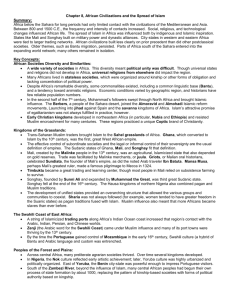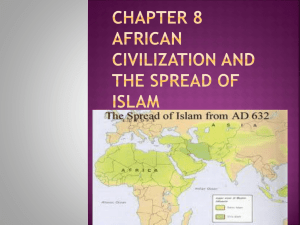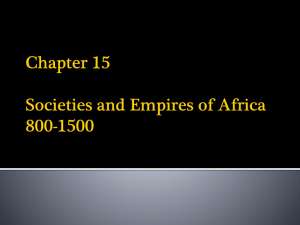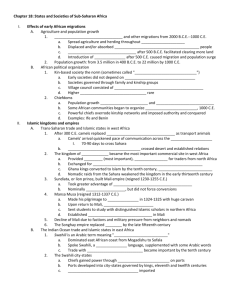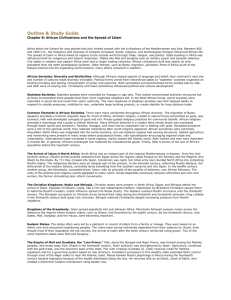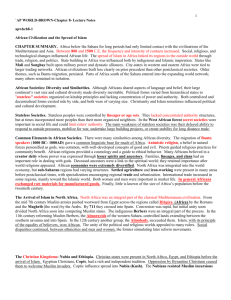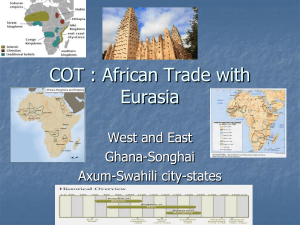African Civilization and the Spread of Islam
advertisement
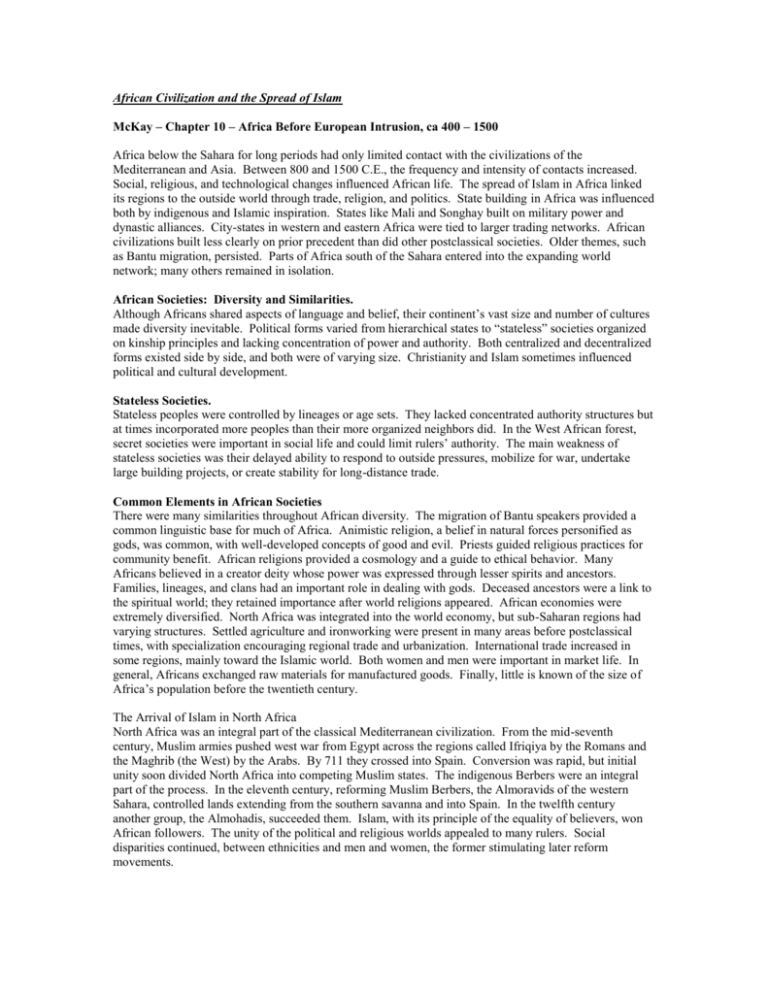
African Civilization and the Spread of Islam McKay – Chapter 10 – Africa Before European Intrusion, ca 400 – 1500 Africa below the Sahara for long periods had only limited contact with the civilizations of the Mediterranean and Asia. Between 800 and 1500 C.E., the frequency and intensity of contacts increased. Social, religious, and technological changes influenced African life. The spread of Islam in Africa linked its regions to the outside world through trade, religion, and politics. State building in Africa was influenced both by indigenous and Islamic inspiration. States like Mali and Songhay built on military power and dynastic alliances. City-states in western and eastern Africa were tied to larger trading networks. African civilizations built less clearly on prior precedent than did other postclassical societies. Older themes, such as Bantu migration, persisted. Parts of Africa south of the Sahara entered into the expanding world network; many others remained in isolation. African Societies: Diversity and Similarities. Although Africans shared aspects of language and belief, their continent’s vast size and number of cultures made diversity inevitable. Political forms varied from hierarchical states to “stateless” societies organized on kinship principles and lacking concentration of power and authority. Both centralized and decentralized forms existed side by side, and both were of varying size. Christianity and Islam sometimes influenced political and cultural development. Stateless Societies. Stateless peoples were controlled by lineages or age sets. They lacked concentrated authority structures but at times incorporated more peoples than their more organized neighbors did. In the West African forest, secret societies were important in social life and could limit rulers’ authority. The main weakness of stateless societies was their delayed ability to respond to outside pressures, mobilize for war, undertake large building projects, or create stability for long-distance trade. Common Elements in African Societies There were many similarities throughout African diversity. The migration of Bantu speakers provided a common linguistic base for much of Africa. Animistic religion, a belief in natural forces personified as gods, was common, with well-developed concepts of good and evil. Priests guided religious practices for community benefit. African religions provided a cosmology and a guide to ethical behavior. Many Africans believed in a creator deity whose power was expressed through lesser spirits and ancestors. Families, lineages, and clans had an important role in dealing with gods. Deceased ancestors were a link to the spiritual world; they retained importance after world religions appeared. African economies were extremely diversified. North Africa was integrated into the world economy, but sub-Saharan regions had varying structures. Settled agriculture and ironworking were present in many areas before postclassical times, with specialization encouraging regional trade and urbanization. International trade increased in some regions, mainly toward the Islamic world. Both women and men were important in market life. In general, Africans exchanged raw materials for manufactured goods. Finally, little is known of the size of Africa’s population before the twentieth century. The Arrival of Islam in North Africa North Africa was an integral part of the classical Mediterranean civilization. From the mid-seventh century, Muslim armies pushed west war from Egypt across the regions called Ifriqiya by the Romans and the Maghrib (the West) by the Arabs. By 711 they crossed into Spain. Conversion was rapid, but initial unity soon divided North Africa into competing Muslim states. The indigenous Berbers were an integral part of the process. In the eleventh century, reforming Muslim Berbers, the Almoravids of the western Sahara, controlled lands extending from the southern savanna and into Spain. In the twelfth century another group, the Almohadis, succeeded them. Islam, with its principle of the equality of believers, won African followers. The unity of the political and religious worlds appealed to many rulers. Social disparities continued, between ethnicities and men and women, the former stimulating later reform movements. The Christian Kingdom: Nubia and Ethiopia Christian states were present in North Africa, Egypt, and Ethiopia before the arrival of Islam. Egyptian Christians, Copts, had a rich and independent tradition. Oppression by Byzantine Christians caused them to welcome Muslim invaders. Coptic influence spread into Nubia (Kush). The Nubians resisted Muslim incursions until the thirteenth century. The Ethiopian successors to Christian Axum formed their state during the thirteenth and fourteenth centuries. King Lalibela in the Thirteenth century built great rock churches. Ethiopia retained Christianity despite increasing pressure from Muslim neighbors. Kingdoms of the Grasslands. Islam spread peacefully into sub-Saharan Africa. Merchants followed caravan routes across the Sahara to the regions where Sudanic states, such as Ghana, had flourished by the eighth century. By the thirteenth century, new states, Mali, Songhay, and the Hausa, were becoming important. Sudanic States The states often were led by a patriarch or council of elders from a family or lineage. They were based on an ethnic core and conquered neighboring peoples. The rulers were sacred individuals separated from their subjects by rituals. Even though most of their population did not convert, the arrival of Islam after the tenth century reinforced ruling power. Two of the most important states were Mali and Songhay. The Empire of Mali and Sundiata, the “Lion Prince.” Mali, along the Senegal and Niger Rivers, was formed among the Malinke peoples, who broke away from Ghana in the thirteenth century. Ruler authority was strengthened by Islam. Agriculture, combined with the gold trade was the economic base of the state. The ruler (mansa) Sundiata (d. 1260) receives credit for Malinke expansion and for a governing system based on clan structure. Sundiata’s successors in this wealthy state extended Mali’s control through most of the Niger valley to near the Atlantic coast. Mansa Kankan Musa’s pilgrimage to Mecca during the fourteenth century became legendary because of the wealth distributed along the way. He returned with an architect, Ishak al-Sahili, who created a distinctive Sudanic architecture using beaten clay. City Folk and Villagers. Distinctive regional towns, such as Jenne and Timbuktu, whose residents included scholars, craft specialists, and foreign merchants, developed in the western Sudan. Timbuktu was famous for its library and university. The military expansion of Mali and Songhay contributed to their strength. Mandinka juula traders ranged across the Sudan. Most of Mali’s population lived in villages and were agriculturists. Despite poor soils, primitive technology, droughts, insect pests, and storage problems, the farmers, working small family holdings, supported themselves and their imperial states. The Songhay Kingdom The Songhay people dominated the middle reaches of the Niger valley. Songhay became an independent state in the seventh century. By 1010, the rulers were Muslims and had a capital at Gao. Songhay won freedom from Mali by the 1370s and prospered as a trading state. An empire was formed under Sunni Ali (1464 – 1492), a great military leader, who extended rule over the entire middle Niger valley. He developed a system of provincial administration to secure the conquests. Sunni Ali’s successors were Muslim rulers with the title of askia; by the mid-sixteenth century, their state dominated the central Sudan. Daily life followed patterns common in savanna states; Islamic and indigenous traditions combined. Men and women mixed freely; women went unveiled and young girls at Jenne were naked. Other states that combined Muslim and pagan ways rose among the Hausa of northern Nigeria. In the fourteenth century, the first Muslim ruler of Kano made the Hausa city a center of Muslim learning. Along with other Hausa cities, Kano followed the Islamic-indigenous amalgam present in the earlier grasslands empires. Traders and other Muslims widely spread influences, even in regions without Islamic states. Political and Social Life in the Sudanic States Larger states were ruled by a dominant group. Islam provided a universal faith and a fixed law that served common interests. Indigenous political and social patterns persisted in the unified states. Rulers reinforced authority through Muslim officials and ideology, but existing traditions continued to be vital, since many of their subjects were not Muslims. The fusion of traditions shows in the status of women. Many Sudanic societies were matrilineal and did not seclude women. Slavery and a slave trade to the Islamic world lasting more than 700 years had a major effect on women and children. All individuals might become slaves, but the demand for concubines and eunuchs increased demand for women and children. The Swahili Coast of East Africa A series of trading ports, part of the Indian Ocean network, developed along the coast and islands between the Horn of Africa and Mozambique. Town residents were influenced by Islam, but most of the general population remained tied to traditional ways. The Coastal Trading Ports Bantu-speaking migrants had reached and mixed with indigenous Africans early in the first millennium C.E. Immigrants from Southeast Asia had migrated to Madagascar from the second century B.C.E. With the rise of Islam, individuals from Oman and the Persian Gulf settled in coastal villages. By the thirteenth century, a mixed Bantu and Islamic culture, speaking the Bantu Swahili Language, emerged in a string of urbanized trading ports. They exported raw materials in return for Indian, Islamic, and Chinese luxuries. As many as 30 towns flourished, their number including Mogadishu, Mombasa, Malindi, Kilwa, Pate, and Zanzibar. From the thirteenth to the fifteenth century, Kilwa was the most important. All were tied together by coastal commerce and by an inland caravan trade. The Mixture of Cultures on the Swahili Coast The expansion of Islamic influence in the Indian Ocean facilitated commerce. It built a common bond between rulers and trading families and allowed them to operate under the cover of a common culture. Apart from rulers and merchants, most of the population, even in the towns, retained African beliefs. A dynamic culture developed, using Swahili as its language, and incorporating African and Islamic practices. Linage passed through both maternal and paternal lines. There was not a significant penetration of Islam into the interior. “BIG Picture” In Depth: Two Transitions in the History of World Population Even though determining the size and structure of historical populations is very difficult, their study has become a valued tool for better understanding the past. Demographic research presents an opportunity for uncovering aspects of the politics and economy of past societies. Regular census taking became common only in some societies during the eighteenth century. Until then, the human population grew slowly, increasing as agriculture and other discoveries opened new resources. By 1750 C.E., the earth had about 500 million inhabitants. Pre-modern economies maintained a rough equality between births and deaths, with most individuals not reaching the age of 35. Since 1750, with the onset of the Industrial Revolution and other developments, a demographic transition, occurring first in Europe, sent world population to more than 5 billion at the end of the twentieth century. Peoples of the Forest and Plains Apart from the peoples of the savanna and eastern coast, by 1000 C.E. most Africans were following their own lines of development. Agriculture, herding and the use of iron implements were widespread. Some large and complex states formed; most were preliterate and transmitted knowledge by oral methods. Artists and Kings: Yoruba and Benin In the central Nigerian forests, the Nok culture flourished between 500 B.C.E. and 200 C.E. Its members developed a realistic art style; they practiced agriculture and used iron tools. After Nok disappeared, there is a long hiatus before the reappearance of regional artistic traditions after 1000 C.E. Non-Bantu-speaking peoples, the Yoruba, were highly urbanized agriculturists organized into small city-states, each controlling radius of about 50 miles. The city-states were under the authority of regional divine kings presiding over elaborate courts. The kings’ power was limited by other societal forces. At Oyo, for example, local lineages controlled provinces while paying tribute to the ruler. In the capital, a council of state and a secret society advised the ruler. Ile-Ife was the holiest Yoruba city; its subjects after 1200 created terra-cotta and bronze portrait heads that rank among the greatest achievements of African art. Similar organizational patterns are found among the Edo peoples to the east. They formed the city-state of Benin in the fourteenth century under the ruler Ewuare. They ruled from the Niger River to the coast near Lagos. Benin’s artists are renowned for their work in ivory and cast bronze. Central African Kingdoms By thirteenth century C.E., Bantu speakers were approaching the southern tip of Africa. By around 1000, they were forming states where kinship patterns were replaced by political authority based on kingship. The Luba peoples, in Katanga, created a form of divine kingship in which the ruler had powers ensuring the fertility of people and crops. A hereditary bureaucracy formed to administer the state, thus allowing the integrating of many people into one political unit. The Kingdoms of the Kongo and Mwene Mutapa The kingdom of the Kongo flourished along the lower Congo River by the late fifteenth century. It was a agricultural society whose people were skilled in weaving, pottery making, blacksmithing, and carving. There was a sharp gender division of labor: women dominated crop cultivation and domestic tasks; men cleared the forest, hunted, and traded. The population resided in small, family-based villages; the area around the capital, Mbanza Kongo, by the sixteenth century included up to 100,000 people. A hereditary central kingship ruled over local nonhereditary chiefs. The Kongo was a federation of states grouped into eight major provinces. To the east, in central Africa, Shona-speaking peoples in the region between the Zambezi and Limpopo Rivers by the ninth century began building royal stone courts (zimbabwe). The largest, Great Zimbabwe, was the center of a state flourishing by the eleventh century. Massive stone buildings and walls were constructed. Its ruler, the Mwene Mutapa, controlled a large territory reaching to the Indian Ocean. Zimbabwe dominated gold sources and trade with coastal ports of the Indian Ocean network. Internal divisions split Zimbabwe during the sixteenth century. Global Connections: Internal Development and External Contacts The spread of Islam had brought large areas of Africa into the global community. The most pronounced contacts south of Sahara were in the Sudanic states and East Africa were a fusion of Islamic and African cultures created an important synthesis. Most of Africa evolved in regions free of Islamic contact. In Benin, the Yoruba states, Great Zimbabwe, and the Kongo, Africans developed their own concepts of kingship and the state. Many other Africans organized their lives in stateless societies. Key Terms Stateless societies Maghrib Almoravids Almohads Ethiopia Lalibela Sahel Sudanic states Mali Juula Mansa Kankan Musa Ishak al-Sahili Sundiata Griots Timbuktu Songhay Askia Muhammad Hausa states Zanj East African trading ports Ibn Batuta Demographic transition Nok Yoruba Ile-Ife Benin Luba Kongo Kingdom Zimbabwe Great Zimbabwe Mwene Mutapa Checking for Knowledge 1. African societies organized around kinship or other forms of obligation and lacking the concentration of political power were ________________ societies. 2. Malinke merchants, __________________, formed small partnerships to carry out trade throughout the Mali empire. 3. Two of the most significant “port” cities of Mali and Jenne and ________________, which lay off the flood plain on the great bend of the Niger River. 4. The successor state to Mali was the independent kingdom of _______________ that formed under a Berber dynasty. 5. The string of urbanized trading ports including Mogadishu, Mombassa, Malindi, Kilwa, Pate, and Zanzibar shared the common Bantu-based and Arabic-influenced _____________ language. 6. The Arabic traveler and commentator _______________ described African societies and cultures in his travel accounts. 7. The change from slow to rapid population growth often associated with the process of industrialization is referred to as the ___________________ True/False 1. Prior to the arrival of the Muslims, Africa was isolated from other civilizations. 2. Like Shang China, the indigenous religions of Africa featured ancestor worship and diviners. 3. Ethiopia remained a Christian kingdom despite Muslim efforts to conquer it. 4. Songhay and Mali are excellent examples of the fusion of Islamic and indigenous African cultures within the context of trade and military expansion. 5. The Sudanic states lacked urbanization. 6. The common cultural element that bound the commercial cities of the East African coast together was use of the Bantu-based language, Swahili.
